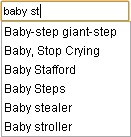|
Predictive Text
Predictive text is an input technology used where one key or button represents many letters, such as on the physical numeric keypads of mobile phones and in accessibility technologies. Each key press results in a ''prediction'' rather than repeatedly sequencing through the same group of "letters" it represents, in the same, invariable order. Predictive text could allow for an entire ''word'' to be input by single keypress. Predictive text makes efficient use of fewer device keys to input writing into a text message, an e-mail, an address book, a calendar, and the like. The most widely used, general, predictive text systems are T9, iTap, eZiText, and LetterWise/WordWise. There are many ways to build a device that predicts text, but all predictive text systems have initial linguistic settings that offer predictions that are re-prioritized to adapt to each user. This ''learning'' adapts, by way of the device memory, to a user's ''disambiguating'' feedback that results i ... [...More Info...] [...Related Items...] OR: [Wikipedia] [Google] [Baidu] |
Input Technology
Input may refer to: Computing * Input (computer science), the act of entering data into a computer or data processing system * Information, any data entered into a computer or data processing system * Input device * Input method * Input port (other) * Input/output (I/O), in computing Other * ''Input'' (talk show) * Input (typeface) * International Public Television Screening Conference (INPUT), an international public television organization * ''Input'' (online magazine), an online technology and culture magazine owned by Bustle Digital Group See also * * Independent variable in a mathematical function * In economics, a factor of production, a resource employed to produce goods and services * Advice (opinion) Advice (also called exhortation) is a form of relating personal or institutional opinions, belief systems, values, recommendations or guidance about certain situations relayed in some context to another person, group or party. Advice is often o ... * Impute ... [...More Info...] [...Related Items...] OR: [Wikipedia] [Google] [Baidu] |
Text Messages
Text messaging, or texting, is the act of composing and sending electronic messages, typically consisting of alphabetic and numeric characters, between two or more users of mobile phones, tablet computers, smartwatches, desktop computer, desktops/laptops, or another type of compatible computer. Text messages may be sent over a cellular network or may also be sent via Satellite phone, satellite or Internet connection. The term originally referred to messages sent using the SMS, Short Message Service (SMS) on mobile devices. It has grown beyond alphanumeric text to include multimedia messages using the Multimedia Messaging Service (MMS) and Rich Communication Services (RCS), which can contain digital images, videos, and sound content, as well as ideograms known as emoji (Smiley, happy faces, sad faces, and other icons), and on various instant messenger, instant messaging apps. Text messaging has been an extremely popular medium of communication since the turn of the century and ... [...More Info...] [...Related Items...] OR: [Wikipedia] [Google] [Baidu] |
Proper Noun
A proper noun is a noun that identifies a single entity and is used to refer to that entity ('' Africa''; ''Jupiter''; '' Sarah''; ''Walmart'') as distinguished from a common noun, which is a noun that refers to a class of entities (''continent, planet, person, corporation'') and may be used when referring to instances of a specific class (a ''continent'', another ''planet'', these ''persons'', our ''corporation''). Some proper nouns occur in plural form (optionally or exclusively), and then they refer to ''groups'' of entities considered as unique (the ''Hendersons'', the '' Everglades'', the '' Azores'', the ''Pleiades''). Proper nouns can also occur in secondary applications, for example modifying nouns (the ''Mozart'' experience; his ''Azores'' adventure), or in the role of common nouns (he's no ''Pavarotti''; a few would-be ''Napoleons''). The detailed definition of the term is problematic and, to an extent, governed by convention. A distinction is normally made in current l ... [...More Info...] [...Related Items...] OR: [Wikipedia] [Google] [Baidu] |
Wired (magazine)
''Wired'' is a bi-monthly American magazine that focuses on how emerging technologies affect culture, the economy, and politics. It is published in both print and Online magazine, online editions by Condé Nast. The magazine has been in publication since its launch in January 1993. Its editorial office is based in San Francisco, California, with its business headquarters located in New York City. ''Wired'' quickly became recognized as the voice of the emerging digital economy and culture and a pace setter in print design and web design. From 1998 until 2006, the magazine and its website, ''Wired.com'', experienced separate ownership before being fully consolidated under Condé Nast in 2006. It has won multiple National Magazine Awards and has been credited with shaping discourse around the digital revolution. The magazine also coined the term Crowdsourcing, ''crowdsourcing'', as well as its annual tradition of handing out Vaporware Awards. ''Wired'' has launched several in ... [...More Info...] [...Related Items...] OR: [Wikipedia] [Google] [Baidu] |
Chinese Characters
Chinese characters are logographs used Written Chinese, to write the Chinese languages and others from regions historically influenced by Chinese culture. Of the four independently invented writing systems accepted by scholars, they represent the only one that has remained in continuous use. Over a documented history spanning more than three millennia, the function, style, and means of writing characters have changed greatly. Unlike letters in alphabets that reflect the sounds of speech, Chinese characters generally represent morphemes, the units of meaning in a language. Writing all of the frequently used vocabulary in a language requires roughly 2000–3000 characters; , nearly have been identified and included in ''The Unicode Standard''. Characters are created according to several principles, where aspects of shape and pronunciation may be used to indicate the character's meaning. The first attested characters are oracle bone inscriptions made during the 13th century&n ... [...More Info...] [...Related Items...] OR: [Wikipedia] [Google] [Baidu] |
Chinese Typewriter
Typewriters that can type Chinese characters were invented in the early 20th century. Written Chinese is a logographic writing system, and facilitating the use of thousands of Chinese characters requires more complex engineering than for a writing system derived from the Latin alphabet, which may require only tens of glyphs. An ordinary Chinese printing office uses 6,000 characters. Models began to be mass-produced in the 1920s. Many early models were manufactured by Japanese companies, following the invention of the Japanese typewriter by Kyota Sugimoto, which used kanji adopted from the Chinese writing system. At least sixty different models of Chinese typewriter have been produced, ranging from sizable mechanical models to electronic word processors. Zhou–Shu design A mechanical engineer from Wuxi, Jiangsu, named Zhou Houkun (''Hou-Kun Chow''; ; ) co-invented the first mass-produced Chinese typewriter. As a student of the Massachusetts Institute of Technology (MIT), Zhou ... [...More Info...] [...Related Items...] OR: [Wikipedia] [Google] [Baidu] |
Autocomplete
Autocomplete, or word completion, is a feature in which an application software, application predicts the rest of a word a user is typing. In Android (operating system), Android and iOS smartphones, this is called predictive text. In graphical user interfaces, users can typically press the tab key to accept a suggestion or the down arrow key to accept one of several. Autocomplete speeds up human-computer interactions when it correctly predicts the word a user intends to enter after only a few characters have been typed into a text input field. It works best in domains with a limited number of possible words (such as in command line interpreters), when some words are much more common (such as when addressing an e-mail), or writing structured and predictable text (as in source code editors). Many autocomplete algorithms learn new words after the user has written them a few times, and can suggest alternatives based on the learned habits of the individual user. Definition Origina ... [...More Info...] [...Related Items...] OR: [Wikipedia] [Google] [Baidu] |
Dictionary
A dictionary is a listing of lexemes from the lexicon of one or more specific languages, often arranged Alphabetical order, alphabetically (or by Semitic root, consonantal root for Semitic languages or radical-and-stroke sorting, radical and stroke for Logogram, logographic languages), which may include information on definitions, usage, etymologies, pronunciations, Bilingual dictionary, translation, etc.Webster's New World College Dictionary, Fourth Edition, 2002 It is a Lexicography, lexicographical reference that shows inter-relationships among the data. A broad distinction is made between general and specialized dictionaries. Specialized dictionaries include words in specialist fields, rather than a comprehensive range of words in the language. Lexical items that describe concepts in specific fields are usually called terms instead of words, although there is no consensus whether lexicology and terminology are two different fields of study. In theory, general dictionarie ... [...More Info...] [...Related Items...] OR: [Wikipedia] [Google] [Baidu] |
Eatoni Ergonomics
LetterWise and WordWise were predictive text entry systems developed by Eatoni Ergonomics (Eatoni) for handheld devices with ambiguous keyboards / keypads, typically non-smart traditional cellphones and portable devices with keypads. All patents covering those systems have expired. LetterWise used a prefix based predictive disambiguation method and can be demonstrated to have some advantages over the non-predictive Multi-tap technique that was in widespread use at the time that system was developed. WordWise was not a dictionary-based predictive system, but rather an extension of the LetterWise system to predict whole words from their linguistic components. It was designed to compete with dictionary-based predictive systems such as T9 and iTap which were commonly used with mobile phones with 12-key telephone keypads. History The court dismissed a claim that Eatoni Ergonomics came into being in the Spring 1998 as an orally agreed partnership between Howard Gutowitz, David A. K ... [...More Info...] [...Related Items...] OR: [Wikipedia] [Google] [Baidu] |




